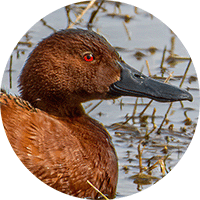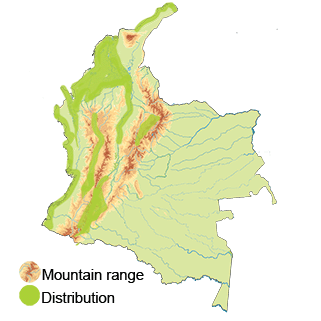Cinnamon Teal
Appearance: The male Cinnamon Teal (41 cm - 16 inches) has a striking plumage. During the breeding season, it exhibits a bright reddish-cinnamon head and neck, a dark maroon chest, and a vibrant blue patch on the wings. The rest of its body is brown. In contrast, the female has a mottled brown appearance throughout the year, with a pale blue patch on the forewing. Brownish chest. Both sexes have long bills.
Habitat: The Cinnamon Teal occupies a variety of wetland habitats. It can be found in areas with suitable freshwater marshes, lakes, ponds, and flooded fields, particularly in the Andean region (up to 3500 m), Magdalena River basin, Ciénaga Grande de Santa Marta, and the eastern plains of the Llanos Orientales.
Behavior: Cinnamon Teals are dabbling ducks, which means they feed by tipping headfirst into the water to reach submerged vegetation and invertebrates. They are known to be highly active during feeding and foraging, often swimming with their heads partially submerged or upending to reach food. These ducks are sociable and tend to gather in small flocks or mixed-species groups.
Breeding: Breeding occurs during the wet season between May and October. The Cinnamon teals construct nests in marshes or grassy areas near water bodies often concealed among vegetation or in floating platforms. The female lays around 8-10 eggs, which she incubates for about 25-28 days. Once hatched, the ducklings are precocial, meaning they can swim and feed shortly after hatching.
Conservation Status: the Cinnamon Teal is considered a resident species, The partial migrant Horned Screamer is listed as "Least Concern" on the IUCN Red List, which means it is not considered to be facing a high risk of extinction.
Distribution
Andean Region: The Cinnamon Teal can be found in the wetlands and freshwater habitats of the Andean region of Colombia. This includes areas such as lakes, marshes, and ponds situated within the Andean valleys and foothills.
Magdalena River Basin: Similar to other waterfowl species, the Cinnamon Teal occurs in wetland areas along the Magdalena River basin. This river system runs through several regions of Colombia, providing suitable habitat for the species
Ciénaga Grande de Santa Marta: This coastal lagoon, located in the Caribbean region of Colombia, serves as a habitat for the Cinnamon Teal. The species can be observed here, particularly during the wet season.
Eastern Plains (Llanos): The Cinnamon Teal occurs in the extensive wetlands of the Eastern Plains, also known as the Llanos. These grassy plains with seasonal flooding provide ideal conditions for the species.
Taxonomy
- Kingdom: Animalia
- Phylum: Chordata
- Class: Aves
- Order: Anseriformes
- Family: Anatidae
- Genus: Spatula
- Species: Spatula cyanoptera
Vocalization
Quacking Call: The most common vocalization of the Cinnamon Teal is a series of quacking sounds. The quacks are often short and repeated in rapid succession. These calls are used for general communication and can vary in pitch and intensity.
Whistling Call: The Cinnamon Teal produces a distinctive whistling call, which is often described as a nasal whistle or a high-pitched "squee-eeee." This call is typically used during courtship displays or as a territorial or contact call.
Whining Call: The ducks occasionally emit a high-pitched, whining call that sounds like a soft, drawn-out "nee-ee" or "wee-ee." This call is often associated with agitation, distress, or alarm.
Grunting Call: During aggressive encounters or territorial disputes, the Cinnamon Teal may emit a low, grunting call. This call is deep and guttural, often described as a soft "gronk" or "gru-unk."






